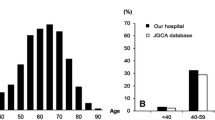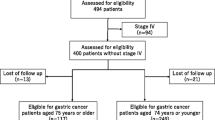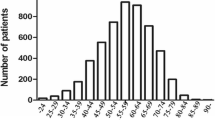Abstract
Background
The worldwide incidence of gastric cancer is gradually declining, however it remains the fourth highest in cancer incidence and the second leading cause of cancer death. Gastric cancer in young people is a disturbing problem and the routine screening does not include people less than 35 years. The clinicopathological features of gastric carcinoma are said to differ between young and elderly patients and it is thought that the prognosis of this disease is worse for younger patients. It is also suggested that the diagnosis is usually made later or have a more aggressive behaviour. Although, others report that tumor staging and prognosis for young patients is similar to older patients and depends on whether the patients undergo a curative resection. All these data need more investigation and studies. Although Portugal has a high incidence of gastric cancer, no studies have yet been performed comparing the clinicopathologic features and prognosis of young and elderly patients with gastric cancer.
Aims
This study intend to assess whether the clinicopathological features and prognosis of gastric cancer in young patients (YGC) is similar to older ones (OGC).
Methods
Between 2000 and 2005, 406 patients with histological diagnosis of primary gastric cancer, treated in the Departments of Surgery and Oncology at the Centro Hospitalar of Vila Nova de Gaia / Espinho, were regularly followed at least for five years after surgery. These were reviewed retrospectively. Several variables were analyzed in young patients and compared with the elder ones. We used the chi-square and Fisher to evaluate the statistical association between categorical variables and t-test for numeric variables. Survival was estimated by the Kaplan-Meier method and used the log-rank test to assess differences in survival among different subgroups of patients. The criteria for statistical significance was p < 0.05. Data analysis was performed using the SPSS 18.
Results and Conclusions
With regard to resectability, 78 % of the tumors were resected in the group of younger patients, the surgery more frequently achieved was total gastrectomy with anastomosis in Y of Roux. In the elder group, about 62 % of the tumors were resected and BII gastrectomy was the most frequent surgery. The diffuse adenocarcinoma was the most frequent histological type in younger patients, whereas in older patients was intestinal adenocarcinoma. With regard to the stage in the first group there was a predominance of stages: IA and IV (26.1 %) in the second: IV (25.8 %). The survival for stage III e IV was significantly worst in YGC compared with OGC.






Similar content being viewed by others
References
Parkin DM (2004) International variation. Oncogene 23:6329–6340
Parkin DM, Bray FI, Devesa SS (2001) Cancer burden in the year 2000, the global picture. Eur J Cancer 37:S4–S66
Forman D, Newell DG, Fullerton F, Yarnell JW, Stacey AR, Wald N, Sitas F (1991) Association between infection with Helicobacter Pylori and risk of gastric cancer: evidence from a prospective investigation. BMJ 302:1302–1305
Parsonnet J, Friedman GD, Vandersteen DP, Chang Y, Vogelman JH, Orentreich N, Sibley RK (1991) Helicobacter pylori infection and the risk of gastric carcinoma. N Engl J Med 325:1127–1131
Milne AN, Sitarz R, Carvalho R, Carneiro F, Offerhaus GJ (2007) Early onset gastric cancer: on the road to unraveling gastric carcinogenesis. Curr Mol Med 7:15–28
El-Omar EM, Carrington M, Chow WH, McColl KE, Bream JH, Young HA, Herrera J, Lissowska J, Yuan CC, Rothman N, Lanyon G, Martin M, Fraumeni JF Jr, Rabkin CS (2000) Interleukin-1 polymorphisms associated with increased risk of gastric cancer. Nature 404:398–402
Milne AN, Offerhaus GJA (2010) Early-onset gastric cancer: Learning lessons from the young. World J Gastrointest Oncol 2(2):59–64
Correa P, Shiao YH (1994) Phenotypic and genotypic events in gastric carcinogenesis. Cancer Res 54:1941s–1943s
Maehara Y, Emi Y, Tomisaki S, Oshiro T, Kakeji Y, Ichiyoshi Y, Sugimachi K (1996) Age-related characteristics of gastric carcinoma in young and elderly patients. Cancer 77:1774–1780
Theuer CP, de Virgilio C, Keese G, French S, Arnell T, Tolmos J, Klein S, Powers W, Oh T, Stabile BE (1996) Gastric adenocarcinoma in patients 40 years of age or younger. Am J Surg 172:473–476
Hamilton SR, Aaltonen LA. World Health Organization Classification of Tumors. Pathology and Genetics of Tumors of the Digestive System. Lyon, France: IARC Press, 2000: 204
Ramos De la Medina A, Salgado-Nesme N, Torres-Villalobos G, Medina-Franco H (2004) Clinicopathologic characteristics of gastric cancer in a young patient population. J Gastrointest Surg 8:240–244
Medina-Franco H, Heslin MJ, Cortes-Gonzalez R (2000) Clinicopathological characteristics of gastric carcinoma in young and elderly patients: a comparative study. Ann Surg Oncol 7:515–519
Matley PJ, Dent DM, Madden MV, Price SK (1988) Gastric carcinoma in young adults. Ann Surg 208:593–596
Kokkola A, Sipponen P (2001) Gastric carcinoma in young adults. Hepatogastroenterology 48:1552–1555
Lim S, Lee HS, Kim HS, Kim YI, Kim WH (2003) Alteration of E-cadherin-mediated adhesion protein is common, but microsatellite instability is uncommon in young age gastric cancers. Histopathology 42:128–136
Maeta M, Yamashiro H, Oka A, Tsujitani S, Ikeguchi M, Kaibara N (1995) Gastric cancer in the young, with special reference to 14 pregnancy-associated cases: analysis based on 2,325 consecutive cases of gastric cancer. J Surg Oncol 58:191–195
Derakhshan MH, Liptrot S, Paul J, Brown IL, Morrison D, McColl KE (2009) Oesophageal and gastric intestinal-type adenocarcinomas show the same male predominance due to a 17 year delayed development in females. Gut 58:16–23
Furukawa H, Iwanaga T, Imaoka S, Hiratsuka M, Fukuda I, Kabuto T, Ishikawa O, Sasaki Y (1989) Multifocal gastric cancer in patients younger than 50 years of age. Eur Surg Res 21:313–318
Suriano G, Oliveira C, Ferreira P, Machado JC, Bordin MC, De Wever O, Bruyneel EA, Moguilevsky N, Grehan N, Porter TR, Richards FM, Hruban RH, Roviello F, Huntsman D, Mareel M, Carneiro F, Caldas C, Seruca R (2003) Identification of CDH1 germline missense mutations associated with functional inactivation of the E-cadherin protein in young gastric cancer probands. Hum Mol Genet 12:575–582
Suriano G, Yew S, Ferreira P, Senz J, Kaurah P, Ford JM, Longacre TA, Norton JA, Chun N, Young S, Oliveira MJ, Macgillivray B, Rao A, Sears D, Jackson CE, Boyd J, Yee C, Deters C, Pai GS, Hammond LS, McGivern BJ, Medgyesy D, Sartz D, Arun B, Oelschlager BK, Upton MP, Neufeld-Kaiser W, Silva OE, Donenberg TR, Kooby DA, Sharma S, Jonsson BA, Gronberg H, Gallinger S, Seruca R, Lynch H, Huntsman DG (2005) Characterization of a recurrent germ line mutation of the E-cadherin gene: implications for genetic testing and clinical management. Clin Cancer Res 11:5401–5409
Carneiro F, Oliveira C, Suriano G, Seruca R (2008) Molecular pathology of familial gastric cancer, with an emphasis on hereditary diffuse gastric cancer. J Clin Pathol 61:25–30
Nakamura R, Saikawa Y, Takahashi T, Takeuchi H, Asanuma H, Yamada Y, Kitagawa Y (2011) Retrospective analysis of prognostic outcome of gastric cancer in young patients. Int J Clin Oncol 16(4):328–334
Ramos-De la Medina A, Salgado-Nesme N et al (2004) Clinicopathologic characteristics of gastric cancer in a young patient population. J Gastrointest Surg 8(3):240–244
Koea JB, Karpeh MS, Brennan MF (2000) Gastric cancer in young patients: demographic, clinicopathological, and prognostic factors in 92 patients. Ann Surg Oncol 7(5):346–351
Hiyama T, Tanaka S, Yoshihara M, Sasao S, Kose K, Shima H, Tuncel H, Ueno Y, Ito M, Kitadai Y, Yasui W, Haruma K, Chayama K (2004) Chromosomal and microsatellite instability in sporadic gastric cancer. J Gastroenterol Hepatol 19:756–760
Wu M, Semba S, Oue N, Ikehara N, Yasui W, Yokozaki H (2004) BRAF/K-ras mutation, microsatellite instability, and promoter hypermethylation of hMLH1/MGMT in human gastric carcinomas. Gastric Cancer 7:246–253
Hirahashi M, Yao T, Matsumoto T, Nishiyama K, Oya M, Iida M, Tsuneyoshi M (2007) Intramucosal gastric adenocarcinoma of poorly differentiated type in the young is characterized by Helicobacter pylori infection and antral lymphoid hyperplasia. Mod Pathol 20(1):29–34
Chung HW, Noh SH, Lim JB (2010) Analysis of demographic characteristics in 3242 young age gastric cancer patients in Korea. World J Gastroenterol 16(2):256–263
Smith BR, Stabile BE (2009) Extreme aggressiveness and lethality of gastric adenocarcinoma in the very young. Arch Surg 144(6):506–510
Santoro R, Carboni F, Lepiane P, Ettorre GM, Santoro E (2007) Clinicopathological features and prognosis of gastric cancer in young European adults. Br J Surg 94(6):737–742
Lai JF, Kim S, Li C, Oh SJ, Hyung WJ, Choi WH, Choi SH, Wang LB, Noh SH (2008) Clinicopathologic characteristics and prognosis for young gastric adenocarcinoma patients after curative resection. Ann Surg Oncol 15(5):1464–1469
Author information
Authors and Affiliations
Corresponding author
Rights and permissions
About this article
Cite this article
Tavares, A., Gandra, A., Viveiros, F. et al. Analysis of Clinicopathologic Characteristics and Prognosis of Gastric Cancer in Young and Older Patients. Pathol. Oncol. Res. 19, 111–117 (2013). https://doi.org/10.1007/s12253-012-9530-z
Received:
Accepted:
Published:
Issue Date:
DOI: https://doi.org/10.1007/s12253-012-9530-z




